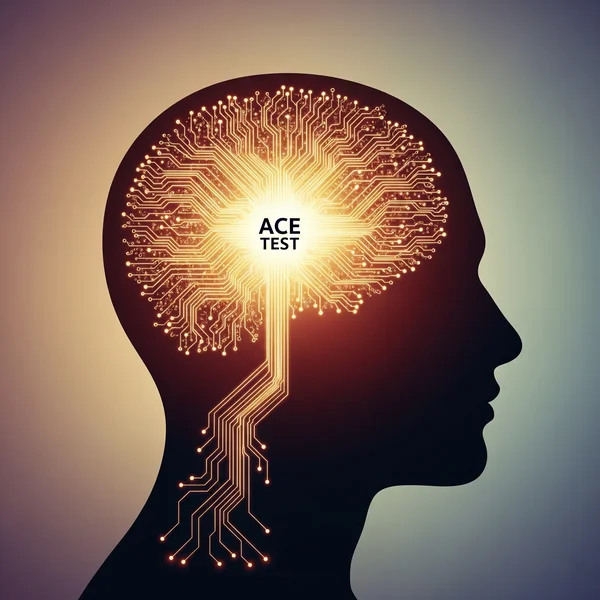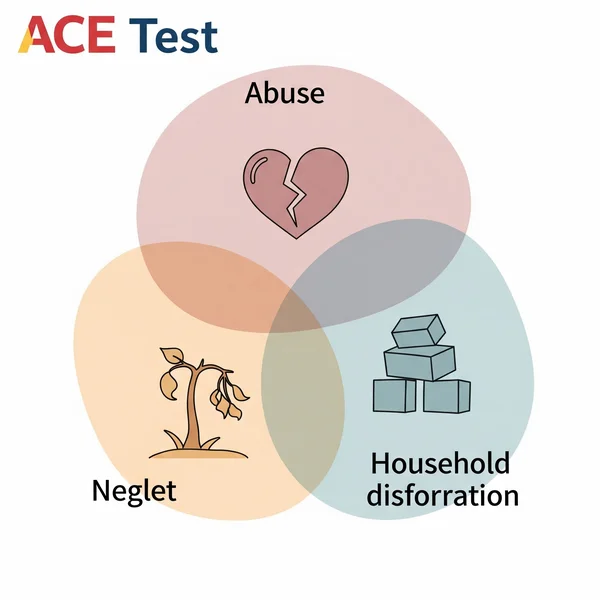什么是 ACE 测试?一份全面的指南
您是否曾想过,早年的经历是如何塑造您当前的幸福感的?许多人听说过 ACE 测试,并会问,ACE 测试具体是指什么,它是否与他们听说过的医学检测有关?“ACE”这个词本身就可能引起混淆。本综合指南将揭开 ACE 测试 的神秘面纱,解释其源自具有里程碑意义的 CDC-Kaiser ACE 研究,说明其目的、测量内容,以及至关重要的是,它如何区别于 ACE 血液测试等其他测试。了解这个强大的工具可能是迈向更深层次的自我认知和更健康未来的第一步。如果您对自己的经历感到好奇,可以 在线探索 ACE 测试。
理解 ACE 测试:您需要了解的内容

ACE 测试 不只是另一个在线测验;它是一个基于重要科学研究的强大工具,旨在帮助个人理解 儿童逆境经历 (adverse childhood experiences) 对其生活的潜在影响。了解 什么是 ACE 分数 可以提供宝贵的见解。
ACE 测试的起源:开创性的 CDC-Kaiser ACE 研究
那么,ACE 测试 的概念起源于何处?ACE 测试 的基础源自于一项开创性的 CDC-Kaiser Permanente 儿童逆境经历 (ACE) 研究,该研究于 1995 年至 1997 年进行。这项大规模流行病学研究涉及了超过 17,000 名参与者,是首次系统调查 童年创伤 (childhood trauma) 与成年健康和幸福之间联系的研究之一。研究结果意义深远,揭示了 ACE 经历的数量与成年期多种负面健康和社会结果风险增加之间存在着一种强烈的、分级的关系。这项开创性的 ACE 科研成果 强调了解决早期生活压力至关重要。
定义儿童逆境经历 (ACEs):该范畴包括哪些内容?
ACE 测试测量什么? 其核心是,ACE 测试 评估在 18 岁之前暴露于各种形式的 儿童逆境经历 (ACEs) 的情况。这些经历通常分为三种主要类型:
- 虐待:
- 情感虐待
- 身体虐待
- 性虐待
- 忽视:
- 情感忽视
- 身体忽视
- 家庭功能失调 / 家庭困境:
- 目睹家庭暴力
- 家庭成员滥用药物
- 家庭成员患有精神疾病
- 父母分居或离婚
- 家庭成员被监禁
理解这些 ACEs 的类型 对于掌握 ACE 评估 的范围至关重要。
进行 ACE 测试的目的和重要性
为什么有人应该考虑进行 ACE 测试 或 ACES 测试?其主要目的不是贴标签或诊断,而是为了培养自我认知和理解。通过识别过去的 儿童逆境经历,个人可以:
- 深入了解这些经历可能如何影响他们当前的身体健康、心理健康,甚至是人际关系模式。
- 认识到自己并不孤单;许多人都有类似的 童年创伤 经历。
- 将这些知识作为起点,寻求适当的支持、资源或 创伤知情关怀。
- 赋予自己能力,以便就自己的健康和康复之旅做出明智的决定。
本质上,理解 ACEs 可以是个人成长中的一个关键时刻。
ACE 测试的工作原理:深入了解评估过程

现在我们已经介绍了“是什么”和“为什么”,让我们来探讨一下 ACE 测试 本身是如何运作的。ACE 测试是如何进行的 当您在线进行测试时?
ACE 问卷中的关键类别
典型的 ACE 问卷,例如如果您 决定在此处进行 ACE 测试 可以获得的问卷,包含一系列直接的“是”或“否”问题。这些问题经过精心设计,旨在反映原始 CDC-Kaiser ACE 研究 中确定的十个核心 儿童逆境经历 类别。例如,问题可能涉及到在您 18 岁生日之前,您是否经常或非常频繁地感到不被支持、不被爱,或者您的家人并不互相照应(这表明情感忽视或虐待),或者您是否与有饮酒问题或使用街头毒品的人同住。目的是广泛了解不同类型的重大 早期逆境压力。
您的 ACE 分数象征着什么(简要概述)
完成 ACE 问卷 后,您将获得一个 ACE 分数。该分数是您回答“是”的不同 ACE 类别数量的简单计数。例如,如果您经历了身体虐待并与患有精神疾病的父母同住,您的 ACE 分数 将是 2。
至关重要的是要理解,更高的 ACE 分数 表明暴露于更多的 儿童逆境经历。源自 CDC-Kaiser ACE 研究 的研究表明,更高的 ACE 分数 与成年期各种健康和社会问题发生几率增加之间存在相关性。然而,这个分数并非对您未来的决定性预测。许多 ACE 分数较高的人过着健康、充实的生活,这通常是通过韧性和适当的支持实现的。我们将在未来的文章中更深入地探讨 如何解读 ACE 分数。
ACE 测试与医学 ACE 血液测试:澄清常见的误解
最常见的困惑之一是关于针对 童年创伤 的 ACE 测试 与所谓的“ACE 血液测试”之间的区别。ACE 测试和血液检测一样吗? 答案是明确的否。
ACE 童年创伤测试:侧重于经历
本文所述的 ACE 测试(或 ACES 测试),以及您可以在 此处找到的自我评估版本,是一个 心理自我报告问卷。其唯一目的是帮助个人识别和量化他们根据 CDC-Kaiser ACE 研究 所定义的 儿童逆境经历 的暴露程度。它是一个关于生活经历的反思和认知工具,而不是在实验室进行的医学诊断测试。
医学 ACE(血管紧张素转化酶)血液测试:完全不同的目的
经常引起混淆的“ACE 血液测试”是指一项医学实验室测试,用于测量血液中血管紧张素转化酶 (ACE) 的水平。这种酶在调节血压方面起着作用。医生可能会订购 ACE 血液测试,以帮助诊断和监测某些疾病,例如肉样瘤病,或评估某些药物的有效性。它与评估 童年创伤 或 儿童逆境经历 完全无关。缩写的相似性纯属巧合。
为什么理解您的 ACEs 对您的幸福感至关重要

掌握您的 ACEs 的重要性可以是改善您整体幸福感的转型一步。什么是 ACE 分数,如果它不是理解您个人历史一部分的关键呢?
儿童逆境经历的潜在长期影响
ACE 科研成果 的体系非常庞大且仍在不断增长。研究一致表明,暴露于多种 儿童逆境经历 可能会产生持久影响,增加以下风险:
- 身体健康问题: 慢性疾病,如心脏病、糖尿病、肥胖症、自身免疫性疾病和慢性疼痛。
- 心理健康挑战: 抑郁症、焦虑症、创伤后应激障碍 (PTSD)、物质使用障碍以及自杀企图风险增加。
- 行为和社会问题: 人际关系、教育和就业方面的困难。
请记住,这些是 潜在 风险,而非必然结果。
ACE 测试作为自我认知和治愈的工具
ACE 测试 的真正力量在于其培养自我认知的能力。认识到某些当前的挣扎或健康问题可能与过去的 童年创伤 有关,这可能非常有意义。它可以将叙述从“我为什么会这样?”转变为“我经历了什么?”这种转变对于治愈至关重要。此处 解释的 ACE 测试 旨在成为一个赋能的第一步。它可以为寻求 创伤知情支持、制定应对策略和培养韧性打开大门。
拥抱认知:在了解 ACE 测试后的下一步行动
理解 ACE 测试——它来自 CDC-Kaiser ACE 研究 的科学依据,它衡量 儿童逆境经历 的内容,以及它与医学血液测试的根本区别——是一个重要的步骤。这些知识不是要用您的过去来定义您,而是要赋予您认知能力。它是一个工具,可以帮助您理解您早年经历对您今天的影响,并为您提供一条通往更深层次的自我关怀和明智选择以促进您幸福感的道路。
如果您准备好获得个人见解,我们邀请您 在线参加我们的保密 ACE 测试,以更好地了解您自己的经历。
关于 ACE 测试的常见问题解答
以下是人们常问的一些关于 ACE 测试 的问题:
ACE 测试是心理健康状况的诊断工具吗?
不,ACE 测试 不是诊断工具。虽然高 ACE 分数 可能表明某些心理健康状况的风险增加,但诊断只能由合格的医疗保健专业人员做出。该测试是用于筛查 儿童逆境经历 的工具。您可以在我们的平台上 了解更多关于 ACE 测试及其目的的信息。
最初的 ACE 研究是由谁开发的?
最初的 儿童逆境经历 (ACE) 研究 是美国疾病控制与预防中心 (CDC) 和 凯撒医疗机构 (Kaiser Permanente) 圣地亚哥预防医学部门 合作的成果。
我的 ACE 分数会随着时间改变吗?
您的 ACE 分数,因为它衡量的是 18 岁之前发生的经历,通常不会改变。这些是历史事件。然而,您对这些经历的 应对方式 以及您的康复和复原之旅 会 随着时间显著改变。
ACE 测试是保密的吗?
是的,当您 与我们一起进行 ACE 测试 时,您的回答和分数是保密的,旨在为您提供个人见解。我们优先考虑您的隐私。
我可以在哪里在线进行 ACE 测试?
您可以通过 访问我们的评估页面 来进行基于原始 CDC-Kaiser ACE 研究 问题的保密在线 ACE 测试。这是了解您经历的有价值的第一步。